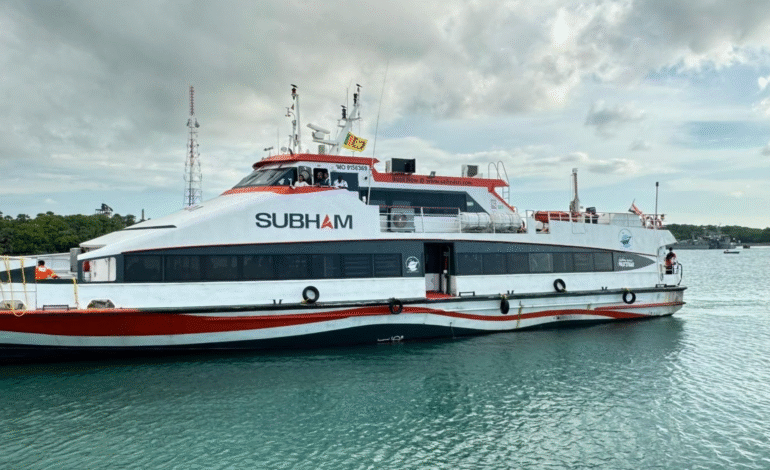India Extends Support for Tamil Nadu-Sri Lanka Ferry Service

The Government of India has officially extended its financial support for the international passenger ferry service between Nagapattinam in Tamil Nadu and Kankesanthurai in northern Sri Lanka. This extension reaffirms India’s continued commitment to enhancing regional maritime connectivity and strengthening historic people-to-people ties with its southern neighbor.
According to a statement from the Indian High Commission in Colombo, the funding will continue for an additional year. This is part of India’s broader efforts to support regional infrastructure and mobility while facilitating affordable cross-border travel for citizens of both nations.
Viability Gap Funding Ensures Continued Operation of the Service
The financial support is being provided under the Viability Gap Funding (VGF) scheme, amounting to over LKR 300 million annually, which is approximately USD 1 million. The funding will be used to cover logistical and operational costs necessary to keep the ferry running smoothly and affordably.
The VGF mechanism is widely used for infrastructure projects that are economically necessary but not immediately profitable. Through this initiative, India helps maintain operational sustainability while ensuring the ticket prices remain accessible to travelers, thereby boosting usage and dependability.
This continuation of support follows the same structure as the previous year, providing the operators with financial stability and confidence in maintaining regular schedules.
Ferry Service Facilitates Over 15,000 Passenger Journeys Since August 2024
Since its resumption in August 2024, the ferry service has already transported over 15,000 passengers, offering a four-hour journey across the Palk Straits. The service connects two culturally and historically linked regions, supporting family visits, tourism, trade, and religious pilgrimages.
The return of this ferry route has added a vital transportation alternative between the two countries, especially beneficial to travelers seeking a more economical option than air travel. It complements existing aviation routes while reviving an ancient maritime connection.
More Affordable Than Air Travel Between Chennai and Jaffna
One of the most attractive aspects of this ferry service is its cost-effectiveness. Compared to flights between Chennai, India, and Jaffna, Sri Lanka, the ferry offers significantly cheaper fares, making travel more accessible to students, families, tourists, and small traders.
Flight tickets on this route can often be prohibitively expensive, particularly during peak seasons or holidays. In contrast, the ferry’s consistent pricing and short travel time make it a convenient and economical choice, especially for regular travelers and those with cultural or familial ties.
This affordability is central to the success of the ferry and is directly enabled by the financial aid provided through the VGF scheme.
A Milestone in Rebuilding Regional Maritime Connectivity
The revival of the ferry service between Tamil Nadu and northern Sri Lanka represents a key milestone in the broader effort to restore regional maritime routes. Historically, the Palk Straits served as a bridge between the two regions, supporting centuries of interaction through trade, culture, and migration.
By supporting this ferry service, India and Sri Lanka are helping to rebuild a historically significant connection that predates modern borders. The initiative aligns with ongoing efforts to strengthen sub-regional integration in South Asia through infrastructure and people-centric diplomacy.
The ferry’s operation not only symbolizes the restoration of ancient sea routes but also acts as a stepping stone for future maritime cooperation across the region.
Cultural Ties Reinforced by People-to-People Connectivity
Tamil Nadu and the northern provinces of Sri Lanka share deep-rooted cultural and linguistic bonds. These ties go beyond political borders, encompassing shared traditions, religious festivals, and social customs. The ferry service thus plays an important role in reinforcing cultural identity and promoting mutual respect between the people of both regions.
Pilgrims traveling to religious sites, scholars attending events, and families reconnecting across the sea all benefit from this mode of transport. The ability to travel affordably and comfortably strengthens emotional and familial bonds, which have often been strained due to lack of accessible transportation.
This service enhances cross-border exchanges, fostering dialogue and cooperation at the grassroots level.
Comfortable and Safe Journey With Positive Passenger Feedback
Since its launch, the ferry service has been lauded for its safety protocols, passenger comfort, and efficient operations. The four-hour journey is seen as a more relaxed alternative to the busy airports, with simplified boarding processes and a chance to enjoy scenic views of the Indian Ocean.
Onboard facilities are structured to ensure safety and convenience, including trained staff, safety equipment, and access to basic amenities. Travelers have reported satisfaction with the comfort and time-efficiency offered by this form of travel.
Additionally, the service helps reduce carbon emissions, as short-distance sea travel tends to have a lower environmental impact than domestic flights, especially when ferry vessels are maintained with fuel-efficient practices.
Opportunities for Economic and Trade Collaboration
Beyond passenger travel, the ferry service opens up possibilities for enhanced trade and small business activity. As the service matures, authorities may explore the integration of light cargo or trade shipments, especially between local producers and micro-enterprises on both sides.
This could facilitate a low-cost logistics network, benefiting fishermen, artisans, and traders in both Tamil Nadu and northern Sri Lanka. Increased ferry traffic can also boost local port economies, encouraging the development of services like transport, retail, food, and lodging around the terminals.
Over time, this could translate into greater regional economic resilience, creating job opportunities and enabling bilateral commercial partnerships at the grassroots level.
Administrative Cooperation Key to Operational Success
The smooth functioning of the ferry service depends on strong coordination between Indian and Sri Lankan port authorities, customs officials, and immigration departments. The extension of financial support signals ongoing bilateral commitment to maintaining and improving these cooperative frameworks.
Regular cross-border travel requires clear protocols, synchronized schedules, and effective communication. Ensuring this cooperation is not only beneficial for the ferry’s passengers but also sets a precedent for future regional transport partnerships.
Additionally, administrative synergy can encourage future investment in port infrastructure, digital ticketing systems, and emergency management, enhancing both the efficiency and safety of maritime routes.
Looking Ahead: Vision for Long-Term Sustainability and Expansion
While the ferry service has already demonstrated early success, its long-term sustainability will require continued investment, infrastructure upgrades, and consistent user demand. Authorities are expected to evaluate route performance, gather passenger feedback, and explore potential service expansions.
Future development could include new ferry routes connecting other parts of southern India with eastern Sri Lankan ports, thereby creating a network of regional marine connectivity. These new routes could further ease mobility, support tourism, and promote regional integration in South Asia.
Additionally, there are opportunities to adopt green technologies, such as electric ferries or low-emission fuels, to ensure that environmental goals are met alongside economic and social objectives.
A Model for Affordable, Regional Maritime Mobility
The ongoing financial assistance from India to support the Tamil Nadu–Kankesanthurai ferry service is a significant step toward inclusive, people-centered regional connectivity. By helping more than 15,000 passengers travel since August 2024, the ferry has proven its social, economic, and cultural relevance.
Its affordability, ease of access, and historic symbolism make it a model for cross-border transportation projects that are sustainable, inclusive, and regionally impactful. The Indian government’s decision to continue support under the VGF framework ensures this connectivity is maintained and potentially enhanced in the years ahead.
As the ferry sails between Tamil Nadu and Sri Lanka, it doesn’t just carry passengers — it carries the hopes of a more connected, cooperative, and harmonious South Asian future.







